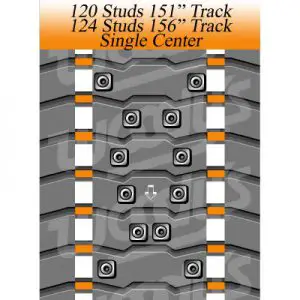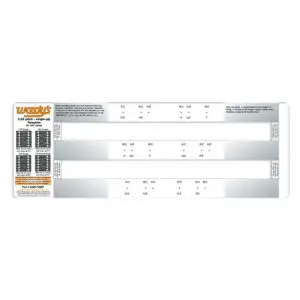
Studded snowmobile tracks create effective traction on icy terrains and packed snow. You can conquer challenging terrain with trusted confidence in your balance and braking ability. Choosing the right snowmobile stud patterns makes sure that your tracks deliver an ideal performance and do not slow you down. The pattern depends on how many studs need to be embedded based on your preference for speeds and cornering ability. For example, fast snowmobilers aim for better grip and holeshot to achieve racing benefits, whereas adventure enthusiasts prefer easy braking and maneuvering.

Studding patterns can have v-shaped designs from various manufacturers. They offer a visual guide to install the studs in a suitable layout, with scaled measurements and placements. Here are some of the most useful snowmobile stud patterns from Woody’s and Stud Boy Traction to help you with convenient installations. But first
Table of Contents
How to Select a Stud Pattern?
There is a wide variety of snowmobile stud patterns available to riders. The ideal option for them will depend on their riding habits, the trails they visit, and their sleds. Here are a few guidelines to select a suitable stud pattern for a snowmobile.
Weight of the Snowmobile and Rider
The weight of the snowmobile is one of the primary factors that riders must consider when choosing a stud pattern for their snowmobile. A sled will require more traction on ice as the load being pulled by it increases. Snowmobiles themselves have a dry weight ranging from 430 to 600 pounds, with fuel and other fluids like lubricant and coolant adding another 50 to 100 pounds. In addition to the sled’s weight, the weight of the rider and the cargo that will be carried must be taken into account. An average adult rider weighs anywhere from 140 to 180 pounds. The gear carried on a sled may easily add up to another 50 pounds. Therefore, in some situations, the cumulative weight may only be 600 pounds, while in others, it can easily reach 800 to 900 pounds. Therefore, riders must select snowmobile stud patterns accordingly for optimum traction and stability.
Engine Horsepower
Engine horsepower is an important specification to examine for selecting appropriate snowmobile stud patterns. Powerful engines with a high displacement capacity rating and horsepower are best paired with snowmobile stud patterns with a large number of studs. Riders must consider options with at least 140 to 160 studs for these. Less populated snowmobile stud patterns are better matched with lighter, smaller engines.
Riding Style
The appropriate snowmobile stud patterns for riders will also depend on their riding style. Studs on the center of the track have the maximum effect on acceleration. Riders who want speed and travel on straight, flat trails will find snowmobile stud patterns with a higher number of studs at the center suitable. Studs on the outer belt of the track are responsible for improving steering and cornering. Riders who have to navigate curvy trails or regions will want snowmobile stud patterns with sufficient studs towards the outside.
Also, for heavy trail riding or aggressive acceleration, the number of studs will be on the higher side, while lighter riders can make do with snowmobile stud patterns with a relatively lower number. An optimal snowmobile stud pattern will prolong the life of the studs and the track.
Track Length and Width
The track length and width also determine the suitable snowmobile stud patterns. Wider and longer tracks have more surface area and, therefore, can accommodate more studs. Riders can install anywhere from 168 to 240 studs on such tracks. Smaller and narrower tracks may support fewer studs. They may be suitable for only 72 to 120 snowmobile stud patterns. Medium-sized tracks may feature around 120 to 160 studs. Riders can use the length and width measurements of their sled’s track to determine which snowmobile stud patterns will be ideal.
Snowmobile owners must avoid using the minimum recommended number of studs to stay on the safe side. If the number of studs is inadequate, it may overstress the studs and can pull them out from the track. It may cause tears in the track and result in permanent damage. Users may even have to replace the track in worst-case scenarios if multiple studs get pulled out. An adequate number of studs must be installed for even tension distribution. It will ensure sufficient traction on ice and packed snow for better mobility. Almost all tracks have a recommended snowmobile stud pattern on them. The exact spots where the studs should be installed are clearly marked on them. Not all of them have to be necessarily filled, and it is up to the rider to select an appropriate snowmobile stud pattern.
Woody’s Snowmobile Stud Patterns – 128 TEMPLATE
This snowmobile stud pattern is designed for 2-ply tracks of the following dimensions: [13.5″ x 128″], [14″ x 128″], and [15″ x 128″]. You get to choose from different options for configuring your track. There are 102 and 153 studs with single/double support plates. For instance, you will be able to install 102 studs as pairs using 51 double plates, or insert them individually in 102 single plates. This pattern is only compatible with center belts.
Woody’s LONG TRACK TEMPLATE
Woody’s heavy card stock template for long, 2-ply tracks can be used for your snowmobile’s 2.52 pitch tracks. The supported dimensions are [15″ x 136″], [15″ x 144″], [16″ x 136″], and [16″ x 144″]. The template displays several studding patterns to suit your preferences.
For 136” tracks, you have the following options:
- 108 double studs + 54 double plates
- 162 single/double studs + 54 single/double plates
- 162 single studs + 162 single plates
- 144 single studs + 144 single plates
- 198 single studs + 198 single plates
- 108 single studs + 108 single plates
For 144” tracks, these are the available choices:
- 171 single studs + 171 single plates
- 152 single studs + 152 single plates
- 114 single studs + 114 single plates
Woody’s BEARCAT 154 TEMPLATE
This single-ply track snowmobile stud pattern fits 2.86-pitch tracks of the size 20″ x 154″. The layout includes 108 studs with single support plates to be embedded into the central belt. The template is only compatible with Woody’s Grand studs and support plates. It is a time-saving approach for marking consistent positions to optimize the function of each stud as you cruise along.
Woody’s 286 QUIET PAD TEMPLATE
The heavy card stock guide helps you determine the perfect stud alignment for enhanced traction on your snowmobiling adventures. It is designed for 2-ply tracks that incorporate Quiet Pad technology. Supported sizes of 2.86 pitch tracks include [15″ x 129″] and [15″ x 137″]. Single support plates accommodate 90, 96, 135, or 144 pieces. This snowmobile stud pattern is applicable for studding the center and outer belts of your sled’s tracks.
Studding Template 3.0″ Pitch Single Ply
Woody’s CAD-generated template is also available through Amazon. The studding instructions make sure that each set is placed accurately for 3.00 pitch tracks that are 141” long.
Arctic Cat 180 Stud Pattern from Stud Boy Traction
For the 15 “x129″ x 2.86” track, this template from Stud Boy Traction displays a pattern that iterates every 6 lugs along the surface. You will start marking the placements from the first 6 lug patterns and repeat until the template covers the entire track. Overall, there are 45 lugs, 180 studs, and 24 scratch lines for this Arctic Cat configuration.
These were some examples of snowmobile stud patterns that are designed for efficiency. Strategically embedded carbides must allow ideal conveyor rotation on your tracks. Click here to reach Woody’s interactive guide for traction and template feasibility for your particular sled model. Just enter the details of your snowmobile and receive possible solutions instantly. You can also browse its installation tips for further clarification through this link.
Leave a Reply